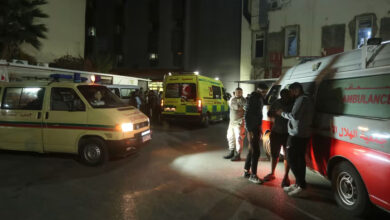Mleeta, Lebanon–Families examine a captured Israeli Merkava tank and the charred remains of armored vehicles and war booty seized from Israeli troops. Lebanese boy scouts pose on grenade launchers and motorcycles and snap photos of each other while visitors from near and far explore Hizbullah’s old tunnel networks and caves along the trail.
This is Mleeta, Hizbullah’s new outdoor museum and park.Before it was turned into a permanent museum exhibit, the Mleeta complex–located in the Iqlim al-Toffah district in south Lebanon–reportedly served as an important military base for the Shia Islamist group Hizbullah during its guerilla campaign against the Israeli occupation of south Lebanon.
It’s new life as a museum and landmark was kicked off on 21 May, just days before the ten-year anniversary of the Israeli withdrawal from Lebanon.
“We hope this tourist jihadi center will be a first step toward preserving the history of our heroic resistance,” Hizbullah leader Hassan Nasrallah said in a speech via video link at the opening ceremony, attended by crowds of cheering supporters, some Lebanese officials, and others.
The multi-million dollar open-air complex covers a around 60,000 square meters and a guided tour through its tunnels, winding trails, and indoor galleries can take up to two hours. Plans are also in place to build a restaurant and an aerial cableway between the Mleeta hill and the nearby town of Sojod.
The first stop in the museum is an area called the “The Abyss,” an abstract gallery dug into the ground where charred remains of seized Israeli armored vehicles and tanks mingle with chunks of steel and metal wires.
“This is a structural scenic art that symbolizes the defeat of Zionist entity,” reads a sign accompanying the display.
Abu Abdallah, a tour guide, explains how work on the museum began in 2006 before the war with Israel that summer.
“Thousands worked on it during day and night,” he says.
Further down the hill, a group of visitors have gathered near a trench to take pictures of a memorial for Hizbullah’s former Secretary General Abbas Musawi who was assassinated by the Israelis in the early 1990s. A large framed photo of the former Hizbullah head has been placed in the ditch along with two machine guns, an open Quran, and a prayer rug. Abu Abdallah says that this was the place where Musawi used to pray.
After a brief pause at a hilltop patio with a magnificent view of south Lebanon, Abo Abdallah instructs visitors to lower their heads. They are about to enter a tunnel.
The lights inside the bunker are dimmed and the tunnel path is narrow. Images of Iran’s late Ayatollah Ruhollah Khomeini and the Islamic Republic’s current supreme leader, Ayatollah Ali Khamenei, have been plastered on the walls.
This is part of a sophisticated tunnel network built deep into the mountain that has a kitchen, a living area, and a working room equipped with computers, radios, and telephones. On the table in the middle of the room lies a large detailed map of south Lebanon and behind it on the wall hangs a large poster of Hizbullah leader Hassan Nasrallah as well as an old calendar from May 2000—the month Israeli troops withdrew from Lebanon.
“There is electricity and there are phones and generators. Everything they could need was here,” says Abu Abdallah.
The group emerges out from the bunker onto a short trail flanked by more rocket launchers and missiles that have been planted on the sides of the pathway before reaching Liberation Square. There is a tall memorial covered in excerpts from a Hassan Nasrallah speech.
“It shows the heroism of the resistance on the ground of the south, their steadfastness,” says forty-year old Um Jafaar when asked her opinion on the Mleeta museum exhibit. “The resistance doesn’t just give blood, it also does great cultural and artistic things.”
Another woman in her mid-40s who declines to give her name said she was so taken by the museum that she couldn’t find words to describe it.
“Just look at the place. It speaks for itself. The resistance will stay strong, God willing,” she says.
Whether its an important symbolic and historic landmark or a kitschy jihadi theme park, the crowds are turning up at Mleeta. Last weekend, 450 students from the Lebanese American University, both Muslim and Christian, reportedly participated in a so-called “dignity trip” to Hizbullah strongholds in the Lebanese south, which included a visit to Mleeta.
Forty-year old museum volunteer Ali emphasizes the importance of visitors fully grasping the symbolism and message of Mleeta.
“We want to show the whole world that we are not terrorists and we have rights just like anyone else. We didn’t plan to fight, the Israelis came and we had to protect ourselves, our children and our land,” he says.
Mleeta may not be Hizbullah’s first commemorative war museum, but it is by far the biggest and most comprehensive exhibition to date.
In 2007 Hizbullah opened the doors to the public to its exhibit of the 2006 war with Israel, titled “House of the Spider” (Beit Al-Ankabut), in Beirut’s southern suburbs of Dahiye—an area which came under heavy shelling during the conflict.
A year later, Hizbullah engineers and architects came together again for a commemorative exposition dedicated to its slain military commander Imad Mughniyah who was killed in a 2008 car explosion in Damascus. Hizbullah blamed his assassination on Israel. The museum exhibition was titled “Al-Imad: The Leader of the Two Victories” and was put on display in the southern Lebanese town of Nabatiyeh. It carried the personal belongs of Mughniyah as well as captured Israeli tanks and armor.
World



